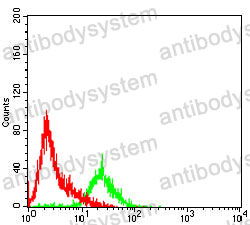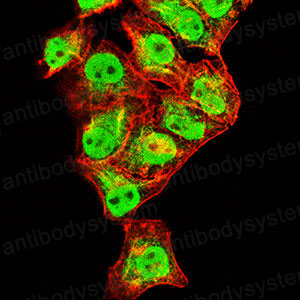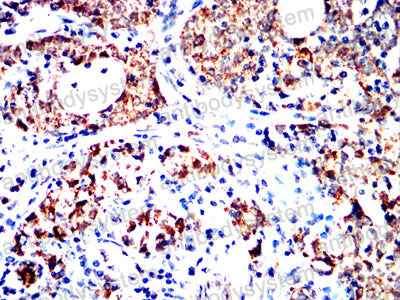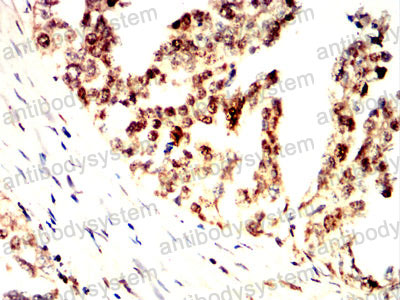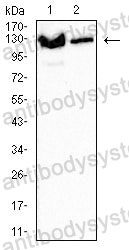Catalog No.
RHF89601
Species reactivity
Human
Host species
Mouse
Isotype
IgG1
Clonality
Monoclonal
Tested applications
ELISA: 1:10000, FCM: 1:200-1:400, IF: 1:50-1:200, IHC: 1:200-1:1000, WB: 1:500-1:2000
Target
Xeroderma pigmentosum group C-complementing protein, p125, XPC, DNA repair protein complementing XP-C cells, XPCC
Concentration
1 mg/ml
Endotoxin level
Please contact with the lab for this information.
Purity
>95% as determined by SDS-PAGE.
Purification
Protein A/G purified from cell culture supernatant.
Accession
Q01831
Applications
ELISA, FCM, IF, IHC, WB
Form
Liquid
Storage buffer
0.01M PBS, pH 7.4, 0.05% Sodium Azide.
Stability and Storage
Use a manual defrost freezer and avoid repeated freeze-thaw cycles. Store at 4°C short term (1-2 weeks). Store at -20°C 12 months. Store at -80°C long term.
Clone ID
R3Q44
Immune checkpoint inhibitors for children with xeroderma pigmentosum and advanced cutaneous squamous cell carcinoma: A case presentation and brief review., PMID:40052589
Dual blockade of IL-17A and IL-36 pathways via a bispecific antibody exhibits enhanced anti-inflammatory potency., PMID:39600699
Direct Functionalization of Polysaccharide-Based Xylan Phenyl Carbonate Nanoparticles with Tumor Cell Specific Antibodies., PMID:38236789
Regulation of XPC Binding Dynamics and Global Nucleotide Excision Repair by p63 and Vitamin D Receptor., PMID:36877866
Recurrent squamous cell carcinoma and a novel mutation in a patient with xeroderma pigmentosum: a case report., PMID:35902966
Vitamin D Receptor Promotes Global Nucleotide Excision Repair by Facilitating XPC Dissociation from Damaged DNA., PMID:33524369
Downregulation of Xeroderma Pigmentosum Complementation Group C Expression by 17-Allylamino-17-Demethoxygeldanamycin Enhances Bevacizumab-Induced Cytotoxicity in Human Lung Cancer Cells., PMID:33202406
Growth and humoral immune effects of dietary Original XPC in layer pullets challenged with Mycoplasma gallisepticum., PMID:32475439
Effects of a Saccharomyces cerevisiae fermentation product in receiving diets of newly weaned beef steers. I. Growth performance and antioxidant defense1., PMID:29912425
An improved method for the detection of nucleotide excision repair factors at local UV DNA damage sites., PMID:28185850
Real-Time Tracking of Parental Histones Reveals Their Contribution to Chromatin Integrity Following DNA Damage., PMID:27642047
Cell Killing Mechanisms and Impact on Gene Expression by Gemcitabine and 212Pb-Trastuzumab Treatment in a Disseminated i.p. Tumor Model., PMID:27467592
Clinicopathological Features of Ophthalmic Neoplasms Arising in the Setting of Xeroderma Pigmentosum., PMID:27172099
This paper is a winner in the Undergraduate category for the SFB awards: Evaluation of the tissue response to alginate encapsulated islets in an omentum pouch model., PMID:27144389
Base and Nucleotide Excision Repair of Oxidatively Generated Guanine Lesions in DNA., PMID:26733197
Functional and mechanistic studies of XPC DNA-repair complex as transcriptional coactivator in embryonic stem cells., PMID:25901318
Repair of UV photolesions in xeroderma pigmentosum group C cells induced by translational readthrough of premature termination codons., PMID:24218596
Malignant melanoma cells acquire resistance to DNA interstrand cross-linking chemotherapeutics by p53-triggered upregulation of DDB2/XPC-mediated DNA repair., PMID:23604128
Clinicopathological significance and prognostic value of Xeroderma pigmentosum complementary group C (XPC) expression in sporadic breast cancer patients., PMID:22038723
DNA repair enzyme polymorphisms and oxidative stress in a Turkish population with gastric carcinoma., PMID:21390502
XPC silencing sensitizes glioma cells to arsenic trioxide via increased oxidative damage., PMID:20403967
Photoactivated DNA analogs of substrates of the nucleotide excision repair system and their interaction with proteins of NER-competent HeLa cell extract., PMID:19538122
[Expression of MMP-9 and VEGF in breast cancer: correlation with other prognostic indicators]., PMID:19142506
Direct involvement of the tumor suppressor p53 in nucleotide excision repair., PMID:18343205
DNA repair triggered by sensors of helical dynamics., PMID:17962020
Influence of XPB helicase on recruitment and redistribution of nucleotide excision repair proteins at sites of UV-induced DNA damage., PMID:17509950
Adduct-specific monoclonal antibodies for the measurement of cisplatin-induced DNA lesions in individual cell nuclei., PMID:16571898
p8/TTD-A as a repair-specific TFIIH subunit., PMID:16427011
DNA repair factor XPC is modified by SUMO-1 and ubiquitin following UV irradiation., PMID:16030353
Recombinant expression of maize nucleotide excision repair protein Rad23 in Escherichia coli., PMID:15866714
Use of mutant mice in photoimmunological and photocarcinogenic investigations., PMID:12231197
Sequential assembly of the nucleotide excision repair factors in vivo., PMID:11511374
Strong functional interactions of TFIIH with XPC and XPG in human DNA nucleotide excision repair, without a preassembled repairosome., PMID:11259578
Characteristics of UV-induced repair patches relative to the nuclear skeleton in human fibroblasts., PMID:10719035
Photocrosslinking locates a binding site for the large subunit of human replication protein A to the damaged strand of cisplatin-modified DNA., PMID:10454616
C-Terminal binding protein is a transcriptional repressor that interacts with a specific class of vertebrate Polycomb proteins., PMID:9858600
Assembly, subunit composition, and footprint of human DNA repair excision nuclease., PMID:9618470
Identification and characterization of XPC-binding domain of hHR23B., PMID:9372923
The inactivation of the XP-C gene does not affect somatic hypermutation or class switch recombination of immunoglobulin genes., PMID:9364218
XPC and human homologs of RAD23: intracellular localization and relationship to other nucleotide excision repair complexes., PMID:8692695
The XPB and XPD DNA helicases are components of the p53-mediated apoptosis pathway., PMID:8675009
Characterization of the properties of a human homologue of Escherichia coli RecQ from xeroderma pigmentosum group C and from HeLa cells., PMID:8790942
Detection of nucleotide excision repair incisions in human fibroblasts by immunostaining for PCNA., PMID:7493631

